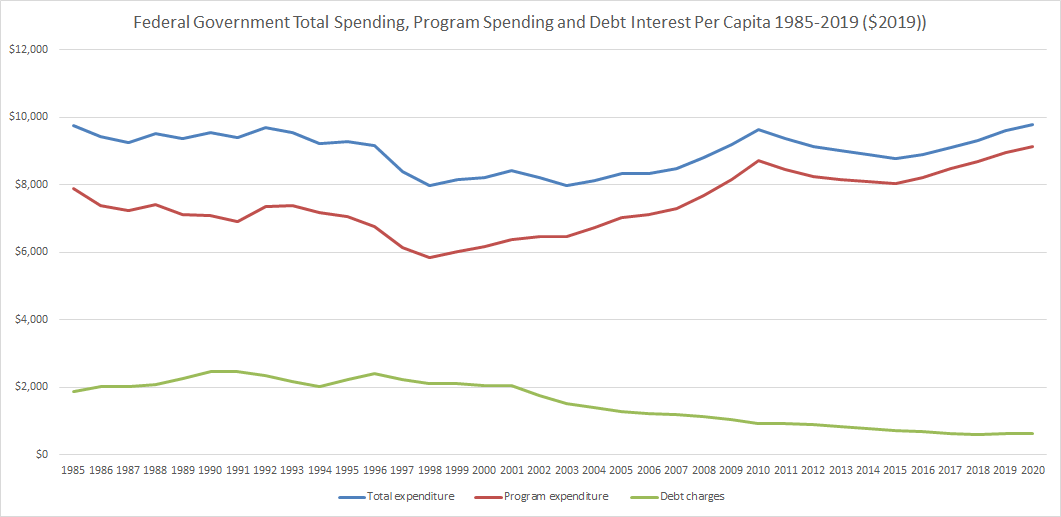The evolution of federal debt interest costs in Canada

In a recent commentary, I argued that for the most part, the past 35 years prior to COVID were marked by a remarkable degree of policy continuity with respect to federal government deficits and debt. I described this policy continuity as a “debt averse” approach.
Starting with the Mulroney government in the mid-1980s, Canada began reducing inflation-adjusted per-capita spending in an effort to shrink a large federal deficit, which had persisted for decades. In the mid-1990s, Jean Chretien’s government reduced spending even more to balance the budget. Between that time and the steep recession of 2008/09, Ottawa consistently ran budget surpluses and saw the country’s debt-to-GDP ratio shrink from 67 per cent in the 1990s to just under 30 per cent in the late 2000s.
Even when deficits emerged in the wake of the 2008/09 recession, the Harper government was committed to return to balance and significantly reduced per-person inflation-adjusted spending. As a result, by 2015, the budget was almost entirely eliminated and Canada had gotten through the great recession with a relatively small increase in its debt-to-GDP ratio.
In short, Liberal and Conservative governments have both, over an extended period of time, prioritized balanced budgets during periods of growth, and shrinking deficits quickly when they did emerge during recessions.
It now seems entirely possible that we have reached the end of this extended era of debt-aversion as a guiding principle of federal fiscal policy. This year’s federal budget deficit is a forecasted $381.6 billion. That’s more than the combined deficits in the 10 years following the 2008/09 financial crisis. This year’s deficit is obviously unusual because of the pandemic, but the Trudeau government has repeatedly signalled that it has big spending plans in the years ahead and that deficit-elimination will not be a priority, at least for a while. In short, it appears our federal government has ditched the debt-averse approach that largely prevailed since the mid-1980s.
In considering the implications of this change, consider some of the advantages to the federal government’s previous debt-averse posture. Of perhaps greatest importance, the past commitment to balanced budgets and deficit-reduction following recessions (coupled with falling interest rates) led to a drastic reduction in money spent each year on debt interest payments.
Let’s compare total spending since 1985 to program spending (all spending minus debt interest). The chart below shows these two indicators since the mid-1980s, using inflation-adjusted per-person dollars. For clarity, the chart also shows per-person inflation-adjusted debt interest payments. Both the orange line and the “wedge” between the green and blue lines illustrate the cost of debt interest payments each year.

Look at the large the gap between the two lines in the early part of this period. In 1993, for instance, federal program spending was (in 2019 dollars) $7,375 per person. Debt charges, however, were $2,164 per person, which brought total spending to $9,539.
So, while governments were spending $9,539 (on average) in taxpayer dollars per person in 1993, taxpayers themselves were only getting $7,375 worth of services. The gap was consumed by debt interest. As a result, for every dollar the federal government spent, Canadians received just 77 cents worth of services.
However, decades of spending reductions and restraint, coupled with falling interest rates, caused debt interest payments—and the wedge between program spending and total spending—to shrink substantially over time. By 2019, the “debt interest wedge” between total and program spending had shrunk to $634 per person—again, down from $2,164 in the early 1990s. By this time, for every dollar the federal government spent, Canadians received 93 cents worth of services.
If the Trudeau government has indeed turned the page on the debt-averse chapter of Canada’s fiscal history, it’s worthwhile to recognize the benefits of that debt-averse approach, which helped shrink debt interest payments—and kept them low—which left a larger share of taxpayer money available for other priorities.
Author:
Subscribe to the Fraser Institute
Get the latest news from the Fraser Institute on the latest research studies, news and events.

